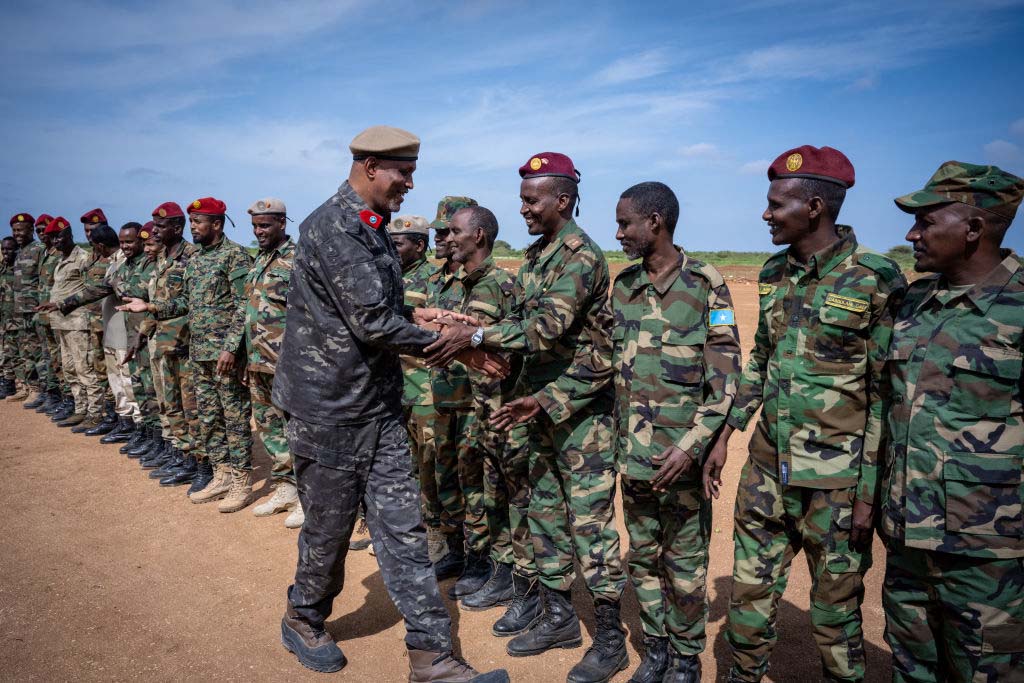ADF STAFF
The Somali government recruited 20,000 Soldiers over the past year to handle security challenges, mainly posed by al-Shabaab, as the African Union Transition Mission in Somalia (ATMIS) draws down.
ATMIS was scheduled to withdraw 2,000 troops from the nation by June 30, the first of three drawdowns in its transition plan. The AU has committed to withdraw the troops gradually and strategically, sector by sector, with an eye toward ending ATMIS by December 31, 2024. Burundi, Djibouti, Ethiopia, Kenya and Uganda contribute troops to the mission.
Thousands of Somali recruits were sent to Egypt, Eritrea, Ethiopia and Uganda for training.
Some observers characterize the plan to train 20,000 Soldiers to defend the nation against al-Shabaab as ambitious, but Mohamed El-Amine Souef, head of ATMIS, said during a June press conference that he believes the Somali government has generated enough forces to take over security responsibilities once ATMIS leaves.
“I have full confidence in the capabilities of the Somali Security Forces,” Souef said. “The SNA [Somali National Army] has over the last one year shown growing ability to conduct military operations against the terrorists group.”
As new recruits continue training, Somali leaders want the United Nations Security Council to lift an arms embargo imposed on the country in 1992, when they argue the security situation was much worse.
In June, Mohamud told the Security Council his government put in place adequate measures to counter the illegal flow of arms and established legislation to control the possession, manufacture, storage and use of firearms.
By lifting the embargo, “you will empower us to assert our sovereignty, effectively combat terrorism and build a peaceful and prosperous future for our nation,” Mohamud said in a Voice of America (VOA) report.
Mohamud was echoed by Souef.
“We must support SSF [Somalia Security Force] leadership, hold liberated areas and take over FOBs [forward operating bases],” Souef said. “These forces require resources to fight al-Shabab and stabilize newly liberated areas.”
On June 29, Burundian Soldiers attached to ATMIS handed over the Cadale FOB in HirShabelle State to the SNA, the fourth base handed over so far in the transition.
Burundi contingent commander Brig. Gen. Jean Claude Niyiburana offered advice to SNA’s brigade commander in Cadale, Col. Saney Abdulle, at the handover ceremony.
“You know this area better and al-Shabaab continues to target Somali security forces and ATMIS troops across all sectors,” Niyiburana said in an African Business report. “Stay vigilant as the enemy does not rest.”
Saney pledged to “stay the course and defeat” al-Shabaab.
Although many experts believe that al-Shabaab is weakening, Omar Yusuf Abdulle, a Horn of Africa affairs analyst, said the group will remain a security threat because its ideology alone is enough to inspire violence.
Despite recent military setbacks, al-Shabaab “can still do damage because their leaders are still out there, and they still control large territory in southern Somalia,” Abdulle told VOA. “Also, the die-hard followers of the group are still listening to them and there are probably thousands of them; therefore, the complete defeat of al-Shabab depends on the eradication of the ideology that inspires the terrorist.”

